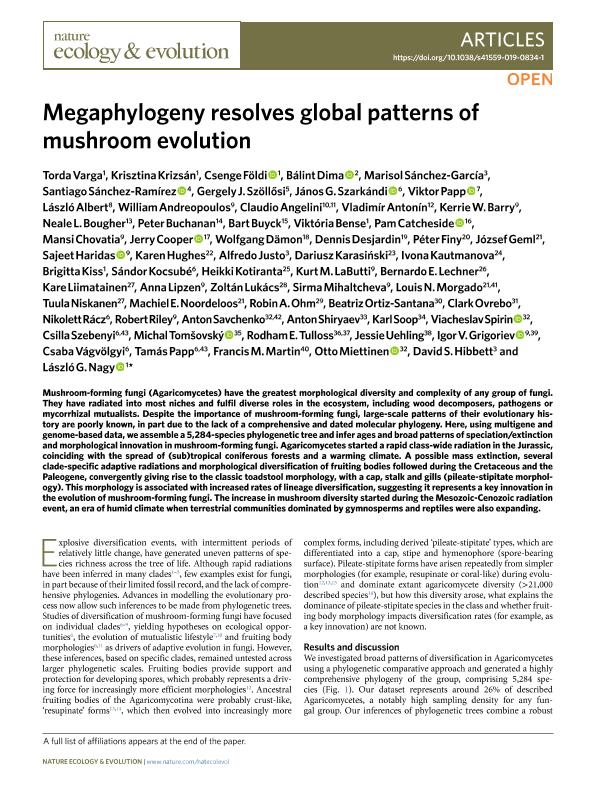Artículo
Megaphylogeny resolves global patterns of mushroom evolution
Varga, Torda; Krizsán, Krisztina; Földi, Csenge; Dima, Bálint; Sánchez-García, Marisol; Lechner, Bernardo Ernesto ; Sánchez-Ramírez, Santiago; Szöllosi, Gergely J.; Szarkándi, János G.; Papp, Viktor; Albert, László; Andreopoulos, William; Angelini, Claudio; Antonín, Vladimír; Barry, Kerrie W.; Bougher, Neale L.; Buchanan, Peter; Buyck, Bart; Bense, Viktória; Catcheside, Pam; Chovatia, Mansi; Cooper, Jerry; Dämon, Wolfgang; Desjardin, Dennis; Finy, Péter; Geml, József; Haridas, Sajeet; Hughes, Karen; Justo, Alfredo; Karasinski, Dariusz
; Sánchez-Ramírez, Santiago; Szöllosi, Gergely J.; Szarkándi, János G.; Papp, Viktor; Albert, László; Andreopoulos, William; Angelini, Claudio; Antonín, Vladimír; Barry, Kerrie W.; Bougher, Neale L.; Buchanan, Peter; Buyck, Bart; Bense, Viktória; Catcheside, Pam; Chovatia, Mansi; Cooper, Jerry; Dämon, Wolfgang; Desjardin, Dennis; Finy, Péter; Geml, József; Haridas, Sajeet; Hughes, Karen; Justo, Alfredo; Karasinski, Dariusz
 ; Sánchez-Ramírez, Santiago; Szöllosi, Gergely J.; Szarkándi, János G.; Papp, Viktor; Albert, László; Andreopoulos, William; Angelini, Claudio; Antonín, Vladimír; Barry, Kerrie W.; Bougher, Neale L.; Buchanan, Peter; Buyck, Bart; Bense, Viktória; Catcheside, Pam; Chovatia, Mansi; Cooper, Jerry; Dämon, Wolfgang; Desjardin, Dennis; Finy, Péter; Geml, József; Haridas, Sajeet; Hughes, Karen; Justo, Alfredo; Karasinski, Dariusz
; Sánchez-Ramírez, Santiago; Szöllosi, Gergely J.; Szarkándi, János G.; Papp, Viktor; Albert, László; Andreopoulos, William; Angelini, Claudio; Antonín, Vladimír; Barry, Kerrie W.; Bougher, Neale L.; Buchanan, Peter; Buyck, Bart; Bense, Viktória; Catcheside, Pam; Chovatia, Mansi; Cooper, Jerry; Dämon, Wolfgang; Desjardin, Dennis; Finy, Péter; Geml, József; Haridas, Sajeet; Hughes, Karen; Justo, Alfredo; Karasinski, Dariusz
Fecha de publicación:
18/03/2019
Editorial:
Nature Publishing Group
Revista:
Nature Ecology & Evolution
ISSN:
2397-334X
Idioma:
Inglés
Tipo de recurso:
Artículo publicado
Clasificación temática:
Resumen
Mushroom-forming fungi (Agaricomycetes) have the greatest morphological diversity and complexity of any group of fungi. They have radiated into most niches and fulfil diverse roles in the ecosystem, including wood decomposers, pathogens or mycorrhizal mutualists. Despite the importance of mushroom-forming fungi, large-scale patterns of their evolutionary history are poorly known, in part due to the lack of a comprehensive and dated molecular phylogeny. Here, using multigene and genome-based data, we assemble a 5,284-species phylogenetic tree and infer ages and broad patterns of speciation/extinction and morphological innovation in mushroom-forming fungi. Agaricomycetes started a rapid class-wide radiation in the Jurassic, coinciding with the spread of (sub)tropical coniferous forests and a warming climate. A possible mass extinction, several clade-specific adaptive radiations and morphological diversification of fruiting bodies followed during the Cretaceous and the Paleogene, convergently giving rise to the classic toadstool morphology, with a cap, stalk and gills (pileate-stipitate morphology). This morphology is associated with increased rates of lineage diversification, suggesting it represents a key innovation in the evolution of mushroom-forming fungi. The increase in mushroom diversity started during the Mesozoic-Cenozoic radiation event, an era of humid climate when terrestrial communities dominated by gymnosperms and reptiles were also expanding.
Palabras clave:
MEGAPHYLOGENY
,
AGARICOMYCETES
Archivos asociados
Licencia
Identificadores
Colecciones
Articulos(INMIBO (EX - PROPLAME))
Articulos de INSTITUTO DE MICOLOGIA Y BOTANICA
Articulos de INSTITUTO DE MICOLOGIA Y BOTANICA
Citación
Varga, Torda; Krizsán, Krisztina; Földi, Csenge; Dima, Bálint; Sánchez-García, Marisol; et al.; Megaphylogeny resolves global patterns of mushroom evolution; Nature Publishing Group; Nature Ecology & Evolution; 3; 18-3-2019; 668-678
Compartir
Altmétricas



